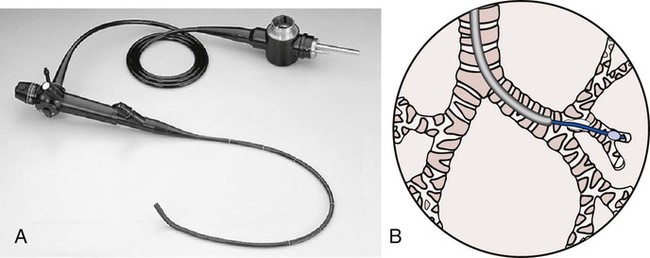After reading this chapter, you will be able to: • Describe the diagnostic values of the sputum examination, and include common organisms associated with respiratory disorders: • Gram-negative organisms (Klebsiella, Pseudomonas aeruginosa, Haemophilus influenzae, Legionella pneumophila) • Gram-positive organisms (Streptococcus, Staphylococcus) • Viral organisms (Mycoplasma pneumoniae, respiratory syncytial virus) • Discuss the diagnostic values of the following tests and procedures: • Endoscopic examinations (bronchoscopy and mediastinoscopy) • Video-assisted thoracoscopy (VATS) • Describe the following components of hematology testing: • Red blood cell (RBC) count (red blood cell indices and types of anemias) • White blood cell (WBC) count, including granular leukocytes and nongranular leukocytes • Describe the role of platelets, including the following: • Causes of platelet deficiency • Clinical significance of platelet deficiency • Identify the following blood chemistry tests commonly monitored in respiratory care: • Serum glutamic oxaloacetic transaminase (SGOT) • Aspartate aminotransferase (AST) • Alanine aminotransferase (ALT) • Identify the following electrolytes commonly monitored in respiratory care: • Define key terms and complete self-assessment questions at the end of the chapter and on Evolve. A sputum sample can be obtained by expectoration, tracheal suction, or bronchoscopy (discussed later). In addition to the analysis of the amount, quality, and color of the sputum (previously discussed in Chapter 2, page 44), the sputum sample may be examined for (1) culture and sensitivity, (2) Gram stain, (3) acid-fast smear and culture, and (4) cytology. For a culture and sensitivity study, a single sputum sample is collected in a sterile container. This test is performed to diagnose bacterial infection, select an antibiotic, and evaluate the effectiveness of antibiotic therapy. The turnaround time for this test is 48 to 72 hours. The Gram staining of sputum is performed to classify bacteria into gram-negative organisms and gram-positive organisms. The results of the Gram stain tests guide therapy until the culture and sensitivity results are obtained. Box 8-1 presents common organisms associated with respiratory disorders. All but the viral organisms can be seen on a Gram stain. A bronchoscopy is a well-established diagnostic and therapeutic tool used by a number of medical specialists, including those in intensive care units, special procedure rooms, and outpatient settings. With minimal risk to the patient—and without interrupting the patient’s ventilation—the flexible fiberoptic bronchoscope allows direct visualization of the upper airways (nose, oral cavity, and pharynx), larynx, vocal cords, subglottic area, trachea, bronchi, lobar bronchi, and segmental bronchi down to the third or fourth generation. Under fluoroscopic control, more peripheral areas can be examined or treated (Figure 8-1). Bronchoscopy may be diagnostic or therapeutic. Therapeutic bronchoscopy includes (1) suctioning of excessive secretions or mucous plugs, especially when lung atelectasis is forming, (2) the removal of foreign bodies or cancer obstructing the airway, (3) selective lavage (with normal saline or mucolytic agents), and (4) management of life-threatening hemoptysis. Although the virtues of therapeutic bronchoscopy are well established, routine respiratory therapy modalities at the patient’s bedside (e.g., chest physical therapy, intermittent percussive ventilation [IPV], postural drainage, deep breathing and coughing techniques, and positive expiratory pressure [PEP] therapy) are considered the first line of defense in the treatment of atelectasis from pooled secretions. Clinically, therapeutic bronchoscopy is commonly used in the management of bronchiectasis, lung abscess, smoke inhalation and thermal injuries, and lung cancer (see Bronchopulmonary Hygiene Therapy Protocol 9-2, page 120). A lung biopsy sample can be obtained by means of a transbronchial needle biopsy or an open-lung biopsy. A transbronchial lung biopsy entails passing a forceps or needle through a bronchoscope to obtain a specimen (Figure 8-2). An open lung biopsy involves surgery to remove a sample of lung tissue. An incision is made over the area of the lung from which the tissue sample is to be collected. In some cases a large incision may be necessary to reach the suspected problem area. After the procedure a chest tube is inserted for drainage and suction for 7 to 14 days. An open-lung biopsy
Other Important Tests and Procedures
Sputum Examination
Endoscopic Examinations
Bronchoscopy
Lung Biopsy
![]()
Stay updated, free articles. Join our Telegram channel

Full access? Get Clinical Tree


Other Important Tests and Procedures

